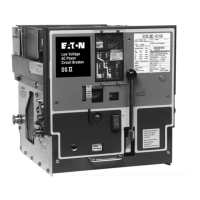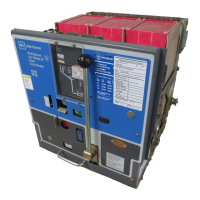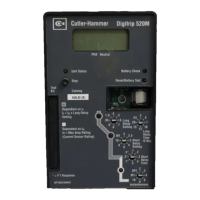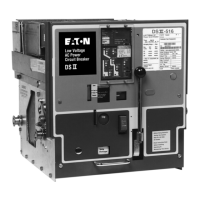I.
B.
694C694-02
rotate the trip latch counterclockwise, but the trip latch is
kept from rotating by overlap of the latch surface of the
trip shaft. A very small rotation of the trip shaft thus
releases the trip latch to rotate counterclockwise to the
position shown
in
Figure 4-7a. The enlarged views of
the trip shaft and trip latch tip
in
Figure 4-7e show
in
detail the rotation of the trip shaft for release of the trip
latch. The entire linkage collapses under the force of the
main contacts and comes to rest with the breaker open
(Figure 4-7a). Note that the trip latch is still
in
the
released position (not reset).
If the breaker stands open with springs charged as
in
Figure 4-7b, and if the trip shaft is held
in
the rotated
or
trip position,
an
attempt to close will result
in
a trip-free
operation. This is so because with the trip shaft
in
the trip
position, there is no restraint on the trip latch. Therefore,
no force is applied to the main link to close the breaker.
Although certain interlocking operations may or will
result
in
this trip-free type of operation, it causes some
extra shock on the mechanism parts. Therefore, trip-free
operations should be avoided.
7
5 4
Page
33
The trip shaft can be rotated to trip the breaker in a
number of ways:
1.
Breaker Trip Plate (Figure 3-3) - Pushing the trip
plate will trip the breaker. This item has a tab which
pushes against a pin on the trip shaft, which applies
a direct rotating force on the shaft
in
the tripping
direction (Figure 4-11).
2. Shunt Trip Device (Refer to Paragraph 3-10.4)
3.
Trip Actuator (Refer to Paragraph 3-7.3)
4.
Compartment Door Trip Flap - If the breaker is
in
the CONNECTED position
in
its compartment, push-
ing the door mounted trip flap will trip the breaker. It
operates through a sliding link and lever fastened to
the drawout cradle floor. When pushed, it engages
the compartment trip lever, extending from the bot-
tom of the breaker, to cause tripping (Figure 3-16).
5. Undervoltage Trip Attachment (Refer to Paragraph 3-
10. 7)
3
.-----=--
.
.:::i
I_
l
I
1
_TEST_
F~
-DISC-
F=!
:)
REMOVE
F
=!
~
G) lnd;catm Index Tab
® Front Panel
@ Levering Worm Shaft
0 Levering Worm
__
_J
® Indicator Pivot Pin
@ Traveling Stop Nut
(j) Traveling Stop Nut Clamp
@ Indicator Lever
Figure 4-1 O Drawout Unit Position Indicator
Effective
07
/97
® Levering Worm
Gear
@)
Levering Shaft
Courtesy of NationalSwitchgear.com

